|
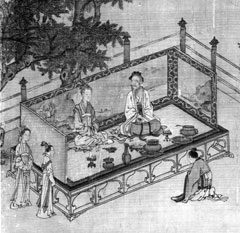 Although the use was similar to the daybed, the couch bed (chuang, luohan chuang) is distinguished by railings, which render it as a more formal piece of furniture. The development of railings may be related with the early placement of screen panels around the back and sides of the platform, which enhanced the sitter as well as provided privacy and protection from drafts. Although the use was similar to the daybed, the couch bed (chuang, luohan chuang) is distinguished by railings, which render it as a more formal piece of furniture. The development of railings may be related with the early placement of screen panels around the back and sides of the platform, which enhanced the sitter as well as provided privacy and protection from drafts.
|
|
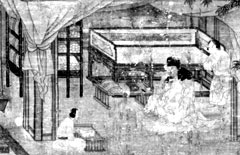 This practice gradually gave rise to decorative railings attached to the seat frame of the platform. This practice gradually gave rise to decorative railings attached to the seat frame of the platform.
|
|
|
By the Ming dynasty, the box-style platform had developed into the more sophisticated open-structured, corner-leg form.
|
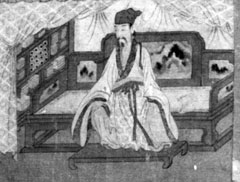
Railings were made in various styles; those configured as throne-like stepped panels are evident from the early Ming period. Literary references also record use of decorative stone for couch bed railings during this time.
|
|
|
Railings were frequently decorated with carving, inlays, or painted lacquer. By the late Ming period, advanced joinery techniques permitted the abandonment of the reinforcing floor stretcher.
|
|
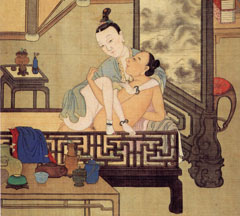 Contemporary to the fashion for hardwood furniture during the late Ming and Qing dynasties, the couch bed was frequently made with plain solid panels of naturally figured wood or with intricate lattice patterns displaying auspicious wanzi, jingzi, or 'carpenter's square' motifs. Contemporary to the fashion for hardwood furniture during the late Ming and Qing dynasties, the couch bed was frequently made with plain solid panels of naturally figured wood or with intricate lattice patterns displaying auspicious wanzi, jingzi, or 'carpenter's square' motifs.
|
|
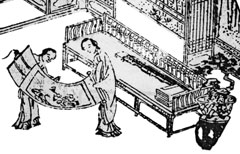 Bamboo was also a favorite material of construction for couch beds—especially the prized speckled bamboo. Bamboo was also a favorite material of construction for couch beds—especially the prized speckled bamboo.
|
|
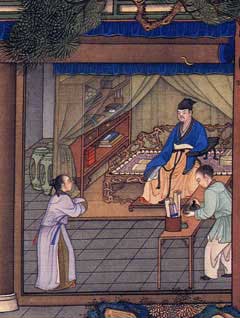 Couch beds contrived from roots also appeared during the the late Ming and Qing dynasties, at a time when Daoist traditions—expressed through rusticity and humble natural materials—became fashionable for those with leisurely lifestyles. Couch beds contrived from roots also appeared during the the late Ming and Qing dynasties, at a time when Daoist traditions—expressed through rusticity and humble natural materials—became fashionable for those with leisurely lifestyles.
|
|
 Although the use was similar to the daybed, the couch bed (chuang, luohan chuang) is distinguished by railings, which render it as a more formal piece of furniture. The development of railings may be related with the early placement of screen panels around the back and sides of the platform, which enhanced the sitter as well as provided privacy and protection from drafts.
Although the use was similar to the daybed, the couch bed (chuang, luohan chuang) is distinguished by railings, which render it as a more formal piece of furniture. The development of railings may be related with the early placement of screen panels around the back and sides of the platform, which enhanced the sitter as well as provided privacy and protection from drafts.
 This practice gradually gave rise to decorative railings attached to the seat frame of the platform.
This practice gradually gave rise to decorative railings attached to the seat frame of the platform.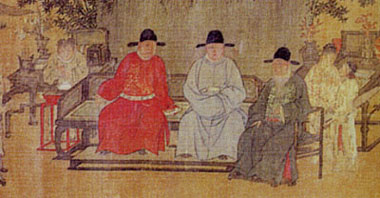

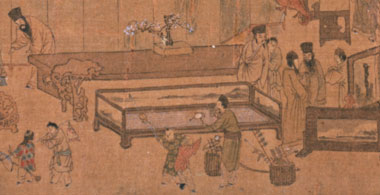
 Contemporary to the fashion for hardwood furniture during the late Ming and Qing dynasties, the couch bed was frequently made with plain solid panels of naturally figured wood or with intricate lattice patterns displaying auspicious wanzi, jingzi, or 'carpenter's square' motifs.
Contemporary to the fashion for hardwood furniture during the late Ming and Qing dynasties, the couch bed was frequently made with plain solid panels of naturally figured wood or with intricate lattice patterns displaying auspicious wanzi, jingzi, or 'carpenter's square' motifs. Bamboo was also a favorite material of construction for couch beds—especially the prized speckled bamboo.
Bamboo was also a favorite material of construction for couch beds—especially the prized speckled bamboo. Couch beds contrived from roots also appeared during the the late Ming and Qing dynasties, at a time when Daoist traditions—expressed through rusticity and humble natural materials—became fashionable for those with leisurely lifestyles.
Couch beds contrived from roots also appeared during the the late Ming and Qing dynasties, at a time when Daoist traditions—expressed through rusticity and humble natural materials—became fashionable for those with leisurely lifestyles.